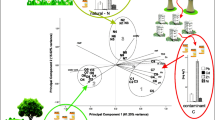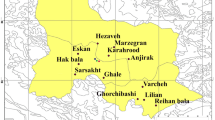Abstract
The aim of the study was to investigate the transfer of toxic metals from honeybee workers (Apis mellifera L.) to bee honey in relation to the ecological state of the environment. The materials of the study consisted of samples of honeybee bodies and varietal honeys taken from the same apiary located in three areas: R1—urbanized (16), R2—ecologically clean (16) and R3—industrialized (15) of south-eastern Poland. The contents of 14 elements in all tested samples, including toxic metals (Cd, Pb, Hg, Al, Ni, Tl) as well as bioelements (K, Mg, Ca, Mn, Fe, Zn, Cu, Se), were analysed by the ICP-OES method with prior microwave mineralization. The concentrations of the majority of the studied elements, excluding aluminum and lead, were significantly higher in bee bodies than in honey samples (P < 0.05). The pollution of bee bodies by toxic metals was dependent on the environmental cleanliness, and the most pollution was observed in the industrialized area. The bee body was the most effective barrier for Cd and Tl transfer to the honey, while the level of Ni was similar in both tested materials. The Al concentration was significantly higher in honey than bee bodies (14.81 ± 24.69 and 6.51 ± 5.83 mg kg−1, respectively), which suggests the possibility of secondary contamination of honey. The greatest sensitivity to heavy metal pollution was observed in honeydew honey compared to nectar honeys (P < 0.05). It was proved for the first time that bees work as biofilters for toxic metals and prevent honey contamination.




Similar content being viewed by others
References
Aghamirlou, H. M., Khadem, M., Rahmani, A., Sadeghian, M., Mahvi, A. H., Akbarzadeh, A., & Nazmara, S. (2015). Heavy metals determination in honey samples using inductively coupled plasma-optical emission spectrometry. Journal of Environmental Health Science and Engineering, 13(1), 39–47. https://doi.org/10.1186/s40201-015-0189-8
Al Naggar, Y. A., Naiem, E. A., Seif, A. I., & Mona, M. H. (2013). Honey bees and their products as a bio-indicator of environmental pollution with heavy metals. Mellifera, 13, 10–20.
Bogdanov, S. (2006). Contaminants of bee products. Apidologie, 37(1), 1–18. https://doi.org/10.1051/apido:2005043
Bogdanov, S., Ryll, G., & Roth, H. (2003). Pesticide residues in honey and beeswax produced in Switzerland. Apidologie, 34, 484–485.
Cempel, M., & Nikel, G. (2006). Nickel: a review of its sources and environmental toxicology. Polish Journal of Environmental Studies, 15, 375–382.
Conti, M. E., & Botrè, F. (2001). Honeybees and their products as potential bioindicators of heavy metals contamination. Environmental Monitoring and Assessment, 69(3), 267–282. https://doi.org/10.1023/A:1010719107006
De Castro, C. S. P., Arruda, A. F., Da Cunha, L. R., SouzaDe, J. R., Braga, J. W. W., & Dórea, J. G. (2010). Toxic metals (Pb and Cd) and their respective antagonists (Ca and Zn) in infant formulas and milk marketed in Brasilia, Brazil. International Journal of Environmental Research and Public Health, 7(11), 4062–4077. https://doi.org/10.3390/ijerph7114062
Devillers, J. (2002). The ecological importance of honey bees and their relevance to ecotoxicology. In J. Devillers and M.-H. Pham-Delegue (Eds.), Honey bees: estimating the environmental impact of chemicals (pp. 1–11). CRC Press 2002. DOI: https://doi.org/10.1201/9780203218655.ch11
Dżugan, M., Zaguła, G., Wesołowska, M., Sowa, P., & Puchalski, C. (2017). Levels of toxic and essential metals in varietal honeys from Podkarpacie. Journal of Elementology, 22(3), 1039–1048. https://doi.org/10.5601/jelem.2016.21.4.1298
Fakhimzadeh, K. (2000). Honey, pollen and bees as indicator of metal pollution. Acta Universitatis Carolinae Environmentalica, 14, 13–20.
Formicki, G., Greń, A., Stawarz, R., Zyśk, B., & Gał, A. (2013). Metal content in honey, propolis, wax, and bee pollen and implications for metal pollution monitoring. Polish Journal of Environmental Studies, 22(1), 99–106.
Garzone, V., D’Alessandro, C., Mininni, R., Addante, R. & Terzano, R. (2002). Bees as bioindicators of environmental metal pollution nearby a large industrial site in Apulia Region. In J. Devillers and M.-H. Pham-Delegue (Eds.), Honey Bees: Estimating the Environmental Impact of Chemicals (pp. 186–247). CRC Press 2002. DOI: https://doi.org/10.1201/9780203218655.ch11
Girotti, S., Maiolini, E., Bolelli, L., Ghini, S., Ferri, E., Barile, N. & Medvedeva, S. (2008). Analytical techniques and bioindicators in environmental control: honeybees, mussels, bioluminescent bacteria: rapid immunoassays for pesticide detection. In: Simeonov L. and Sargsyan V. (Eds.), Soil Chemical Pollution, Risk Assessment, Remediation and Security (pp. 327–347). Springer Science+Business Media B.V. 2008.
Gliga, O. (2016). The content of heavy metals in the bees body depending on location area of hives. Scientific Papers-Animal Science Series: Lucrări Ştiinţifice - Seria Zootehnie, 65, 169–175.
Gutiérrez, M., Molero, R., Gaju, M., van der Steen, J., Porrini, C., & Ruiz, J. A. (2015). Assessment of heavy metal pollution in Córdoba (Spain) by biomonitoring foraging honeybee. Environmental Monitoring and Assessment, 187(10), 651. https://doi.org/10.1007/s10661-015-4877-8
Kacaniova, M., Knazovicka, V., Melich, M., Fikselova, M., Massanyi, P., Stawarz, R., Hascik, P., Pechociak, T., Kuczkowska, A., & Putała, A. (2009). Environmental concentration of selected elements and relation to physicochemical parameters in honey. Journal of Environmental Science and Health. Part A, Toxic/Hazardous Substances & Environmental Engineering, 44(4), 414–422. https://doi.org/10.1080/10934520802659802
Komarnicki, G. J. K. (2005). Lead and cadmium in indoor air and the urban environment. Environmental Pollution, 136(1), 47–61. https://doi.org/10.1016/j.envpol.2004.12.006
Kotaś, J., & Stasicka, Z. (2000). Chromium occurrence in the environment and methods of its speciation. Environmental Pollution, 107(3), 263–283. https://doi.org/10.1016/S0269-7491(99)00168-2
Leita, L., Muhlbachova, G., Cesco, S., Barbattini, R., & Mondini, C. (1996). Investigation of the use of honey bees and honey bee products to assess heavy metals contamination. Environmental Monitoring and Assessment, 43(1), 1–9. https://doi.org/10.1007/BF00399566
Linden, A., Olsson, M., Bensryd, I., Lundh, T., Skerfving, S., & Oskarssona, A. (2003). Monitoring of cadmium in the chain from soil via crops and feed to pig blood and kidney. Ecotoxicology and Environmental Safety, 55(2), 213–222. https://doi.org/10.1016/S0147-6513(02)00079-9
Madejczyk, M., & Baralkiewicz, D. (2008). Characterization of Polish rape and honeydew honey according to their mineral contents using ICP-MS and F-AAS/AES. Analytica Chimica Acta, 617(1-2), 11–17. https://doi.org/10.1016/j.aca.2008.01.038
Naggar, Y. A., Naiem, S. A., Seif, A. I., & Mona, M. H. (2013). Honey bees and their products as a bio-indicator of environmental pollution with heavy metals. Mellifera, 13-26, 10–20.
Porrini, C., Sabatini, A. G., Girotti, S., Ghini, S., Medrzycki, P., Grillenzoni, F., Bortolotti, L., Gattavecchia, E., & Celli, G. (2003). Honeybees and bee products as monitors of the environmental contamination. Apiacta, 38, 63–70.
Reszel, R., Reszel, H., Pęcak J. & Hadam, B. (2003). The content of sulfur and heavy metals in soils of agricultural land and plants of protected areas of the Podkarpackie Voivodship. In: J. A. Tomaszek (Ed.), Postęp w inżynierii środowiska, Oficyna Wydawnicza Politechniki Rzeszowskiej, Rzeszów 2003, pp. 435–445. (in Polish).
Roman, A. (2010). Levels of copper, selenium, lead, and cadmium in forager bees. Polish Journal of Environmental Studies, 19(3), 663–669.
Roman, A., Madras-Majewska, B., & Popiela-Pleban, E. (2011). Comparative study of selected toxic elements in propolis and honey. Journal of Apicultural Science, 55(2), 97–106.
Ruschioni, S., Riolo, P., Minuz, R. L., Stefano, M., Cannella, M., Porrini, C., & Isidoro, N. (2013). Biomonitoring with honeybees of heavy metals and pesticides in nature reserves of the Marche Region (Italy). Biological Trace Element Research Journal, 154(2), 226–233. https://doi.org/10.1007/s12011-013-9732-6
Tanakaa, M., Yamaguchia, Y., Haradaa, Y., Tsuchiyaa, K., & Takakub, Y. (2017). As, Cd and Hg in the organs of Todarodes pacificus, Sepia longipes and Sepia madokai in the East China Sea. Ecotoxicology and Environmental Safety, 145, 103–110. https://doi.org/10.1016/j.ecoenv.2017.06.054
Wajdzik, M., Halecki, W., Kalarus, K., Gąsiorek, M., & Pająk, M. (2017). Relationship between heavy metal accumulation and morphometric parameters in European hare (Lepus europaeus) inhabiting various types of landscapes in southern Poland. Ecotoxicology and Environmental Safety, 145, 16–23. https://doi.org/10.1016/j.ecoenv.2017.06.070
Wesołowska, M., Miąsik, B., Sowa, P., Zaguła, G., & Dżugan, M. (2017). The possibility of secondary contamination of honey during storage in aluminium cans. In M. Dżugan, A. Pasternakiewicz, & M. Wesołowska (Eds.), Environmental influence on the food quality and human health (Vol. 2016, pp. 136–144). Rzeszów: Wydawnictwo Uniwersytetu Rzeszowskiego ISBN 978-83-7996-409-3.
Zhelyazkova, I. (2012). Honeybees—bioindicators for environmental quality. Bulgarian Journal of Agricultural Science, 18(3), 435–442.
Funding
This work was supported financially by the Marshal’s Department of Podkarpackie Voivodeship, project No RPPK.01.03.00-18-040/13, funded by UE.
Author information
Authors and Affiliations
Corresponding author
Rights and permissions
About this article
Cite this article
Dżugan, M., Wesołowska, M., Zaguła, G. et al. Honeybees (Apis mellifera) as a biological barrier for contamination of honey by environmental toxic metals. Environ Monit Assess 190, 101 (2018). https://doi.org/10.1007/s10661-018-6474-0
Received:
Accepted:
Published:
DOI: https://doi.org/10.1007/s10661-018-6474-0




